View in other NatureServe Network Field Guides
NatureServe
Montana
Utah
Wyoming
Idaho
Wisconsin
British Columbia
South Carolina
Yukon
California
New York
Yellow Beeplant - Cleome lutea
Other Names:
Peritoma lutea
State Rank Reason (see State Rank above)
Rare in Montana, where it is currently known from only a small area in the south-central portion of the state. Current population levels and trends are undocumented, though populations likely fluctuate widely from year to year. Additional monitoring is needed.
General Description
Yellow Bee Plant is an annual herb with simple to branched stems that are 10-30 cm high. The leaves have long, 2-6 cm petioles and 3-5 narrowly lance-shaped, 2-6 cm long leaflets that are arranged like the fingers on a hand. Foliage is glabrous to sparsely hairy with a thin, pale, waxy coating. The yellow flowers are borne on 10-20 mm long, ascending stalks, and are densely clustered in a globular inflorescence that greatly expands as the fruit matures. Each flower is subtended by a green bract; the lowest flowers resemble leaves, while the uppermost are short and narrow. Flowers have a 4-lobed calyx and 4 separate petals that are 5-8 mm long. There are 6 stamens, which are greatly exserted beyond the petals. The pod-like capsules are 15-35 mm long and borne on arching stalks that are as long as the fruit.
This species is now being placed in the genus Peritoma in more recent classifications.
Phenology
Flowering in June-July; fruiting in July.
Diagnostic Characteristics
The palmately compound leaves and the yellow, 4-parted flowers with strongly exserted stamens distinguish this species from other species of Cleome; the latter in our area have pinkish flowers.
Species Range
Montana Range
Range Descriptions
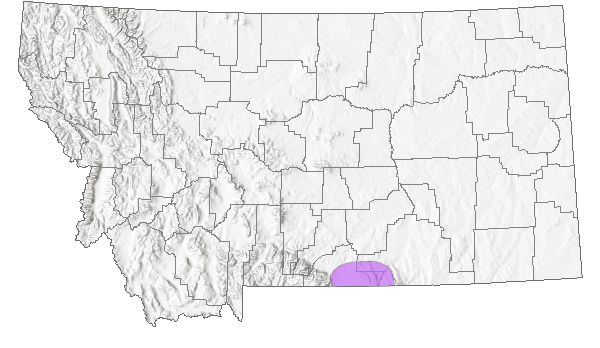
 Native
Native
Range Comments
Eastern WA to CA, east to MT, NE, and TX. Peripheral. In Montana, its native range is thought to be restricted to the Bighorn Basin area in the southcentral part of the state. Occasional introductions into other parts of the state and observations of the species outside of its native range are expected. These populations may be ephemeral.
Observations in Montana Natural Heritage Program Database
Number of Observations: 22
(Click on the following maps and charts to see full sized version)
Map Help and Descriptions
Relative Density
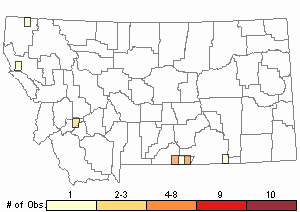
Recency
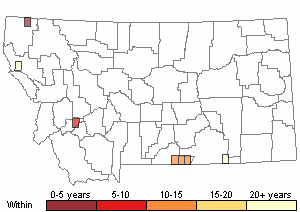
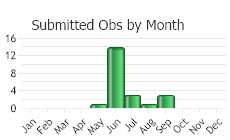
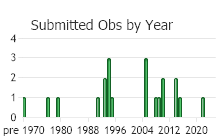
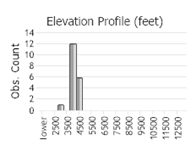 (Observations spanning multiple months or years are excluded from time charts)
(Observations spanning multiple months or years are excluded from time charts)
Habitat
Open, often sandy soil of sagebrush steppe in the valleys.
National Vegetation Classification System Groups Associated with this Species
Shrubland
Arid - Saline Shrubland
Sagebrush Shrubland
Ecology
POLLINATORS The following animal species have been reported as pollinators of this plant species or its genus where their geographic ranges overlap:
Bombus appositus,
Bombus centralis,
Bombus fervidus,
Bombus huntii, and
Bombus rufocinctus (Thorp et al. 1983).
Stewardship Responsibility
Threats or Limiting Factors
STATE THREAT SCORE REASON
Lack of disturbance is a probable threat. At a remediation site along the Clark Fork River, Yellow Beeplant counts declined from 2014 to 2015 as the open habitat became colonized by vegetation through natural ecological succession. The threat score needs to be re-evaluated.
References
- Literature Cited AboveLegend:
 View Online Publication
View Online Publication Thorp, R.W., D.S. Horning, and L.L. Dunning. 1983. Bumble bees and cuckoo bumble bees of California (Hymenoptera: Apidae). Bulletin of the California Insect Survey 23:1-79.
Thorp, R.W., D.S. Horning, and L.L. Dunning. 1983. Bumble bees and cuckoo bumble bees of California (Hymenoptera: Apidae). Bulletin of the California Insect Survey 23:1-79.
- Additional ReferencesLegend:
 View Online Publication
View Online Publication
Do you know of a citation we're missing? Flint, S. D. and M. M. Caldwell. 1984. Partial inhibition of in vitro pollen germination by simulated solar ultrviolet-B radiation. Ecology 65(3):792-795.
Flint, S. D. and M. M. Caldwell. 1984. Partial inhibition of in vitro pollen germination by simulated solar ultrviolet-B radiation. Ecology 65(3):792-795. Gobeille, J.E. 1992. The effect of fire on Merriams turkey brood habitat in southeastern Montana. M.Sc. Thesis. Bozeman, MT: Montana State University. 61 p.
Gobeille, J.E. 1992. The effect of fire on Merriams turkey brood habitat in southeastern Montana. M.Sc. Thesis. Bozeman, MT: Montana State University. 61 p. Lesica, P. and P.L. Achuff. 1992. Distribution of vascular plant species of special concern and limited distribution in the Pryor Mountain desert, Carbon County, Montana. Unpublished report to the Bureau of Land Management. Montana Natural Heritage Program, Helena, MT. 105 pp.
Lesica, P. and P.L. Achuff. 1992. Distribution of vascular plant species of special concern and limited distribution in the Pryor Mountain desert, Carbon County, Montana. Unpublished report to the Bureau of Land Management. Montana Natural Heritage Program, Helena, MT. 105 pp. Lesica, P., M.T. Lavin, and P.F. Stickney. 2012. Manual of Montana Vascular Plants. Fort Worth, TX: BRIT Press. viii + 771 p.
Lesica, P., M.T. Lavin, and P.F. Stickney. 2012. Manual of Montana Vascular Plants. Fort Worth, TX: BRIT Press. viii + 771 p. Lesica, P., M.T. Lavin, and P.F. Stickney. 2022. Manual of Montana Vascular Plants, Second Edition. Fort Worth, TX: BRIT Press. viii + 779 p.
Lesica, P., M.T. Lavin, and P.F. Stickney. 2022. Manual of Montana Vascular Plants, Second Edition. Fort Worth, TX: BRIT Press. viii + 779 p. Lovell, H. B. 1968. Let's talk about honey plants. Gleanings Bee Culture 96(11):675-676, 697.
Lovell, H. B. 1968. Let's talk about honey plants. Gleanings Bee Culture 96(11):675-676, 697. Vanderpool, S., W.J. Elisens, and J.R. Estes. 1989. Crossing relationships and allozyme differentiation among infraspecific taxa of Cleome lutea (Capparaceae). American Journal of Botany 76:278.
Vanderpool, S., W.J. Elisens, and J.R. Estes. 1989. Crossing relationships and allozyme differentiation among infraspecific taxa of Cleome lutea (Capparaceae). American Journal of Botany 76:278. Vanderpool, S.S. and J. R. Estes. 1987. Systematic investigation of Cleome lutea (Capparaceae). American Journal of Botany 74:761.
Vanderpool, S.S. and J. R. Estes. 1987. Systematic investigation of Cleome lutea (Capparaceae). American Journal of Botany 74:761.
- Web Search Engines for Articles on "Yellow Beeplant"





